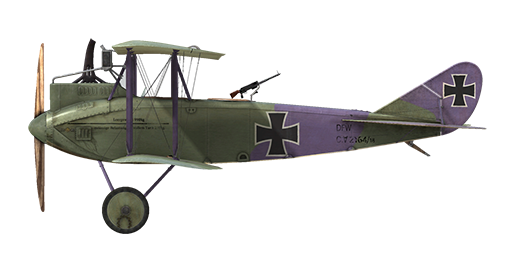il2
DFW C.V

Description
The DFW C.V was a two-seater biplane plane designed and produced at the Deutsche Flugzeug Werke near Leipzig. In designing the aircraft, DFW's designers aimed to create a light but durable airframe. Its structural features included a metal-covered strut in the tail section, a metal cowl protecting the engine, two hollow spars in the wings, and floating ribs. The radiator was mounted above the engine.
The aircraft's first flight occurred on July 11, 1916. After its official trials were completed, the aircraft was sent to the front line where it received perfect reviews. At this point, mass production commenced at other factories, including Aviatik, LVG, and Halberstadt. By the end of the war, 3955 planes of the type had been produced. The C.V became the most numerous German aircraft in its class in WWI.
The DFW C.V entered service in October 1916, initially being sent to special Luftstreitkräfte regiments. Schutzstaffeln began receiving the aircraft in March 1917. The plane was mainly used for bomber escort, artillery spotting, recon, aerial photo reconnaissance and as a personal aircraft in fighter squadrons.
Among its advantages, pilots noted the aircraft's ease of controls and of landing, high climb speed, and good visibility for the observer/gunner. Some frontline reports mentioned equal manoeuvrability to that of the Bristol F.2B Fighter, easy field maintenance, and very good structural durability.
Engine: inline 6 cyl. Benz Bz.IV
Power: 230 hp
Dimensions:
Height: 3140 mm
Length: 7880 mm
Wing span: 13270 mm
Wing surface: 41.52 sq.m
Weight:
Empty: 948.5 kg
Takeoff: 1330 kg
Fuel capacity: 140 l
Oil capacity: 36 l
Speed (IAS), without bombload:
sea level - 157 km/h
1000 - 149 km/h
2000 - 140 km/h
3000 - 132 km/h
4000 - 123 km/h
5000 - 113 km/h
Climb rate, full fuel load, no bombs:
1000 m: 4 min. 1 sec.
2000 m: 8 min. 44 sec.
3000 m: 15 min. 4 sec.
4000 m: 23 min. 55 sec.
5000 m: 39 min. 28 sec.
Service ceiling: 6000 m
Endurance: 2 hours
Armament:
Forward firing: 1 х LMG 08/15 Spandau 7,92mm, 500 rounds
Turret: 1 х LMG 14/17 Parabellum 7,92mm, 3 boxes with 250 rounds each
Bomb load variations:
4 x 12.5kg (50 kg)
16 x 12.5kg (200 kg)
1 x 50 kg + 12 x 12.5 kg (200 kg)
3 x 50 kg + 4 x 12.5 kg (200 kg)
200 kg in total
References:
1) Schlachtflieger by Rick Duiven, Dan-San Abbott.
2) Windsock Datafile 53 DFW C.V by P.M. Grosz.
Modifications
Aldis (Trophy)
Aldis Refractor-type Collimator Sight
Additional mass: 2 kg
Radio
Radio transmitter
Additional mass: 10 kg
20mm Becker Turret
Turret with Becker Automatic Cannon
Ammo: 60 of 20mm rounds (4 magazines with 15 rounds in each)
Ammo type: HE/AP (High Explosive and Armour Piercing rounds)
Rate of fire: 300 rpm
Projectile weight: 120/130 g
Muzzle velocity: 450/490 m/s
Gun weight: 30 kg
Mount weight: 10 kg
Ammunition total weight: 25 kg
Total weight: 65 kg
Estimated speed loss: 6 km/h
P.u.W. Bombs
Up to 12 x 12.5 kg P.u.W. General Purpose Bombs
Additional mass: 186 kg
Ammunition mass: 150 kg
Racks mass: 36 kg
Estimated speed loss before drop: 4 km/h
Estimated speed loss after drop: 2 km/h
Up to 3 x 50 kg P.u.W. General Purpose Bombs
Additional mass: 186 kg
Ammunition mass: 150 kg
Racks mass: 36 kg
Estimated speed loss before drop: 4 km/h
Estimated speed loss after drop: 2 km/h
Additional Gauges
A.Schlegelmilch engine coolant temperature indicator (0-100 °C)
Mechanical Clock
Additional mass: 0.5 kg
Gunsight
Additional sight with front sight and rear sight mountings
Additional mass: 1 kg
Camera
Camera for taking aerial photographs
Additional mass: 10 kg
Twin Parabellum MG Turret
Ring turret with twin Parabellum machine guns.
Ammo: 1500 of 7.92mm rounds (6 drums with 250 rounds in each)
Projectile weight: 10 g
Muzzle velocity: 825 m/s
Rate of fire: 700 rpm
Guns weight: 19 kg (w/o ammo drums)
Mount weight: 5 kg
Ammo weight: 30 kg
Total weight: 54 kg
Estimated speed loss: 8 km/h
Cockpit light
Cockpit illumination lamp for night sorties
Additional mass: 1 kg